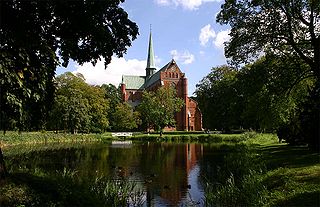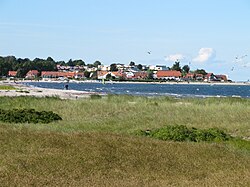
Plön is the district seat of the Plön district in Schleswig-Holstein, Germany, and has about 8,700 inhabitants. It lies right on the shores of Schleswig-Holstein's biggest lake, the Great Plön Lake, as well as on several smaller lakes, touching the town on virtually all sides. The town's landmark is Plön Castle, a chateau built in the 17th century on a hill overlooking the town.

Bad Doberan is a town in the district of Rostock, Mecklenburg-Vorpommern, Germany. It was the capital of the former district of Bad Doberan. In 2012, its population was 11,427.

Eckernförde is a city located in the Kreis of Rendsburg-Eckernförde, Schleswig-Holstein, northern Germany. Situated on the coast of the Baltic Sea, approximately 30 km north-west of Kiel, it has a population of about 23,000. Eckernförde is a popular tourist destination.

Harzgerode is a town in the district of Harz in Saxony-Anhalt, Germany.

Kaltenkirchen is a town located 35 km north of Hamburg in Germany. It is part of the Segeberg district, in Schleswig-Holstein. It has about 20,000 inhabitants.

Bergen auf Rügen is the capital of the former district of Rügen in the middle of the island of Rügen in Mecklenburg-Western Pomerania, Germany. Since 1 January 2005, Bergen has moreover been the administrative seat of the Amt of Bergen auf Rügen, which with a population of over 23,000 is Mecklenburg-Vorpommern's most populous Amt.

Finkenwerder is a quarter of Hamburg, Germany in the borough Hamburg-Mitte. It is the location of the Hamburg Airbus plant and its airport. In 2016 the population was 11,668.

is a municipality and seaside resort on the island Sylt, in the district of Nordfriesland, in Schleswig-Holstein, Germany. It is located north of the island's main town, Westerland. The municipality is part of the AmtLandschaft Sylt. The local economy is dominated by tourism.

Wenningstedt-Braderup is a municipality and seaside resort on the island of Sylt in the district of Nordfriesland, in Schleswig-Holstein, Germany. It is located north of the town of Westerland and is part of the Amt Landschaft Sylt. The local economy is dominated by tourism.

Wasbek is a municipality, immediately west of Neumünster, in the district of Rendsburg-Eckernförde, in Schleswig-Holstein, Germany.

Kronsgaard is a municipality in the district of Schleswig-Flensburg, in Schleswig-Holstein, Germany. Located near Geltinger Bucht, an inlet of the Baltic Sea in the Angeln region, the municipality is assigned to the Geltinger Bucht district. The village of Kronsgaard covers 592 hectares, has around 250 inhabitants and a coastline of around 3 kilometres with a popular natural beach at Pottloch.

Glasau is a municipality in the district of Segeberg, in Schleswig-Holstein, Germany. It is named after the estate and the manor house of the same name. Sarau is the largest village in the municipality; about half of the population lives there.

Poppenbüttel is a quarter in the borough Wandsbek of Hamburg, Germany. In 2020 the population was 24,135.

Holstein Switzerland is a hilly area with a patchwork of lakes and forest in Schleswig Holstein, Germany, reminiscent of Swiss landscape. Its highest point is the Bungsberg. It is a designated nature park as well as an important tourist destination in Northern Germany situated between the cities of Kiel and Lübeck.

The Kellersee is a lake in the Holstein Switzerland region of North Germany. It lies east of the village of Malente on the River Schwentine, has an area of 560 hectares, is up to 27 metres deep and lies at a height of 24 m above sea level (NN). Southeast of the lake is the village of Fissau in the borough of Eutin.

Holsteinische Schweiz station is a railway station by the Kellersee lake on the Malente-Gremsmühlen–Lütjenburg railway in Schleswig-Holstein. It was opened on 25 May 1890. The entire route was built due to the efforts of businessman Johannes Janus, who ran the Hotel Holsteinische Schweiz after which the station was named.

Tourism is an important economic factor for Germany's northernmost state of Schleswig-Holstein.

Hohwacht Bay is a wide bay in the state of Schleswig-Holstein on Germany's Baltic Sea coastline. It is named after the village and seaside resort of Hohwacht. The nearest large town is Oldenburg in Holstein, about 5 kilometres inland. A number of nature reserves fringe the bay and there is a military training area along its eastern shore.

The Malente–Lütjenburg railway was a standard gauge, branch line in the north German state of Schleswig-Holstein. It was built by the businessman, Janus, who ran the Holsteinische Schweiz hotel, that gave its name to the local station on the line. It is currently closed.
Like other areas under Nazi Germany, Jews were persecuted in the northernmost German state Schleswig-Holstein. Before the Nazis came to power in 1933, an estimated 1,900 Jews lived in Schleswig-Holstein, mostly in Lübeck and Kiel. By the time of Nazi Germany's defeat in 1945, many of Schleswig-Holstein's Jews had been murdered in the Holocaust.


























